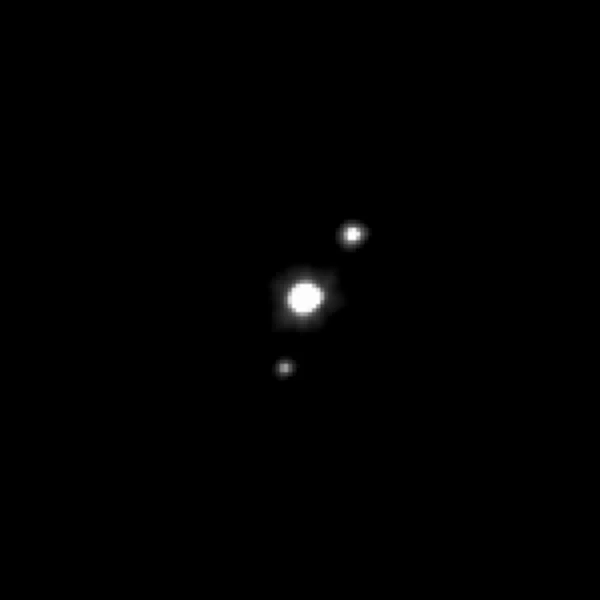
Haumea is one of the most intriguing objects in the Kuiper Belt. Located about 43 AU from the Sun (Neptune ~30 AU), this ellipsoidal dwarf planet is distinguished by an extremely rapid rotation (about 3.9 hours) that has elongated it into a rugby ball shape. This rapid rotation suggests a violent history, probably linked to a giant impact, and complicates precise measurements of its mass and volume. With an average density of about 2.6 g/cm³, Haumea is probably composed of a rocky core surrounded by a layer of water ice. Its high albedo (0.7 to 0.8) reinforces this hypothesis, as crystalline ice strongly reflects solar light.
Discovered in 2017 thanks to the occultation of a star by Haumea, the equatorial ring extends about 2,287 km from the center of the dwarf planet, with a width of about 70 km. This disk of ice particles follows the equator, consistent with the rapid rotation of the central body. The ring is particularly stable, orbits within the 3:1 resonance with Haumea's rotation, and is probably maintained by gravitational resonance effects or viscous dissipation. Its presence is all the more remarkable as only two other small bodies in the Solar System (Chariklo and Chiron, between Jupiter and Neptune) are known to possess one.
Hiʻiaka and Namaka are the two natural satellites of Haumea, discovered in 2005 with the Keck telescope. Hiʻiaka, the largest and most distant (~49,500 km), is probably a block of almost pure ice, while Namaka, closer (~25,700 km), has a strongly perturbed orbit. The orbital configuration of the two moons, which are not on the same plane, indicates a common origin in a collisional event, reinforcing the hypothesis of a massive impact that would have ejected debris, forming both the moons and the collisional family around Haumea.
| Object | Dimensions (km) | Average Distance to Center (km) | Orbital Period | Albedo |
|---|---|---|---|---|
| Haumea | 2,322 × 1,704 × 1,138 | — | Rotation: 3.9154 h | 0.7–0.8 |
| Ring | ~70 (width) | 2,287 | 3:1 Resonance | High (ice) |
| Hiʻiaka | ≈ 310 | 49,500 | 49.1 days | ~0.8 |
| Namaka | ≈ 170 | 25,700 | 18.3 days | ~0.8 |
Sources: Ortiz et al. (2017), AJ • Ragozzine & Brown (2009) • Brown et al. (2007)
The presence of about ten objects around Haumea, called members of its collisional family, is based on several pieces of evidence from observation and physical modeling.
The objects associated with Haumea share very similar orbital characteristics: a semi-major axis around 43 AU, an inclination of about 28°, and moderate eccentricity. They form a coherent group in the space of orbital elements, analogous to asteroid families in the main belt. This coherence suggests that they come from the same cataclysmic event, likely a collision.
All these objects have infrared spectra dominated by crystalline water ice, with clear absorption bands at 1.5 µm and 2.0 µm. This characteristic is rare in the Kuiper Belt, where objects generally have dark surfaces, enriched in irradiated organic compounds (tholins). The high albedo and spectral purity of the members of Haumea's family indicate an origin by ejection of superficial icy material, resulting from an impact.
Researchers have simulated the velocities and expected orbits for fragments resulting from an impact on Haumea. The results show that these fragments, ejected at low velocity (~150 m/s), remain confined in a stable region of the Kuiper Belt. By tracing back the orbital time of these objects, we obtain a convergence towards a common event about 4 billion years ago, reinforcing the hypothesis of an ancient fragmentation.
To date, about a dozen trans-Neptunian objects are identified as very probable members of this family:
Their census is based on the catalogs of the Minor Planet Center and the spectroscopic studies conducted notably by Brown et al. (2007) and Ragozzine & Brown (2009).
The low intrinsic luminosity of these objects greatly limits their detection. It is likely that Haumea's family includes several dozen, or even hundreds of members, but only the largest (from 100 to 400 km) have been detected with current instruments. Statistical modeling of sizes suggests a much larger population, largely hidden in the sky background.
Around Haumea orbits a collisional family, a rarity in the Kuiper Belt. This dozen or so objects sharing similar orbital parameters also have a spectral composition dominated by crystalline water ice. This homogeneity suggests that they all come from the same initial event. These objects are like witnesses to a cataclysmic fragmentation, and they constitute a valuable population for understanding the early moments of the outer solar system.
| Object | Absolute Magnitude (H) | Estimated Diameter (km) | Albedo | Remarks |
|---|---|---|---|---|
| 2002 TX300 | 3.2 | 286 | 0.88 | Dominant crystalline ice |
| 1995 SM55 | 4.8 | 160 | 0.8 (estimated) | Spectrum similar to Haumea |
| 2003 OP32 | 4.0 | 230 | 0.8 | Fast rotation, high reflectance |
| 2005 RR43 | 4.3 | 220 | 0.8 | Near-infrared spectroscopy |
| 2003 UZ117 | 4.7 | 170 | 0.8 (estimated) | Close dynamic group |
| 2003 SQ317 | 5.0 | 150 | 0.7–0.8 | Probable fragment of icy mantle |
| 2009 YE7 | 4.4 | 190 | 0.75 | Orbitally linked to Haumea |
| 2003 HX56 | 5.1 | 140 | 0.75 (estimated) | Possible distant member |
| 2002 GH32 | 4.6 | 180 | 0.8 | Compatible characteristics |
| 2003 EL61 (Haumea) | 0.2 | ~1,620 (spherized) | 0.75 | Parent object of the family |
Data: Minor Planet Center • Ortiz et al. (2017) • Ragozzine & Brown (2009)